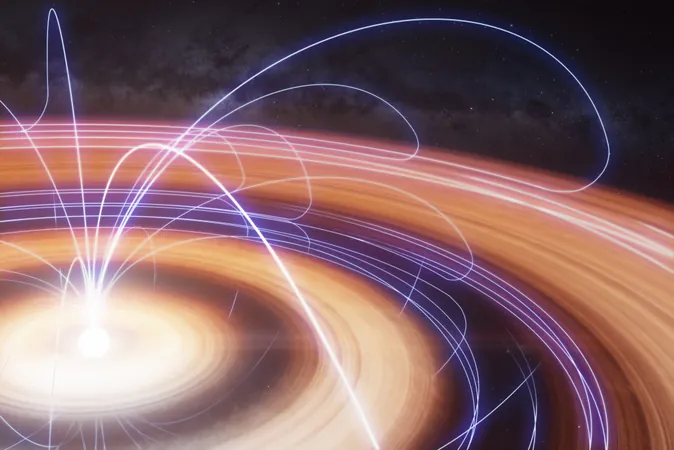
Unlocking Cosmic Secrets: Astronomers Map Magnetic Forces in Planet Formation
2025-09-12
Author: John Tan
Astronomers Unveil Magnetic Fields in Star Formation
In a groundbreaking discovery, astronomers have charted the magnetic fields of TW Hydrae, one of the nearest stars with a planet-forming disk, using the advanced Atacama Large Millimeter/submillimeter Array (ALMA). Spearheaded by Dr. Richard Teague from MIT, this research unveils the hidden forces that influence the creation of new planets — much like those that birthed our own solar system over 4.5 billion years ago.
The Birthplace of Planets: Disks of Gas and Dust
Planets emerge from swirling disks of gas and dust that envelop young stars. While previous observations have mapped the shapes of these disks, deciphering the elusive magnetic fields that shape them has proved challenging. These invisible forces are believed to be essential in guiding the material that contributes to planet formation, but their direct measurement has eluded scientists until now.
Innovative Techniques Unlock Magnetic Insights
Past efforts to identify magnetic fields relied on detecting faint patterns of polarized light, which often got lost in the shuffle of other signals. In a revolutionary approach, Teague and his team focused on the broadening of specific radio signals caused by molecules in the disk, specifically the CN molecule. Through this method, they identified changes indicative of magnetic interactions, a phenomenon recognized as the Zeeman Effect.
Magnetic Fields Found: A Key to Planet Formation
Their analysis revealed magnetic fields with strengths reaching 10 milligauss—fractions of the strength of a refrigerator magnet but significant in the scale of planet formation—extending from 60 to 120 astronomical units (AU) from the star. Notably, the structure of these fields altered at locations marked by gaps in the disk, hinting at a direct correlation between magnetic activity and the formation of regions conducive to planet creation.
A Glimpse into Our Cosmic Origins
Dr. Teague remarked, “The presence and structure of these fields mirror the patterns that likely influenced our solar nebula during its formative years. This is the clearest view we've had of the unseen forces shaping new worlds.” This critical research opens up new avenues for understanding how magnetic fields could dictate the evolution of disks, prompting questions about how they affect planetary formation and positions.
A New Era in Astronomy
With ongoing advancements in telescope sensitivity, astronomers are excited to apply these methods to a wider array of disks. “We’re stepping into an era where we can finally visualize the magnetic frameworks that contribute to new planetary systems,” Teague added, alluding to the imminent upgrades to ALMA designed to enhance these capabilities.
Implications for Cosmic Understanding
This pivotal research signifies a major advancement in our comprehension of planet formation around distant stars and sheds light on the origins of our own solar system. As we decode these cosmic blueprints, the mysteries of our universe continue to unfold.



 Brasil (PT)
Brasil (PT)
 Canada (EN)
Canada (EN)
 Chile (ES)
Chile (ES)
 Česko (CS)
Česko (CS)
 대한민국 (KO)
대한민국 (KO)
 España (ES)
España (ES)
 France (FR)
France (FR)
 Hong Kong (EN)
Hong Kong (EN)
 Italia (IT)
Italia (IT)
 日本 (JA)
日本 (JA)
 Magyarország (HU)
Magyarország (HU)
 Norge (NO)
Norge (NO)
 Polska (PL)
Polska (PL)
 Schweiz (DE)
Schweiz (DE)
 Singapore (EN)
Singapore (EN)
 Sverige (SV)
Sverige (SV)
 Suomi (FI)
Suomi (FI)
 Türkiye (TR)
Türkiye (TR)
 الإمارات العربية المتحدة (AR)
الإمارات العربية المتحدة (AR)